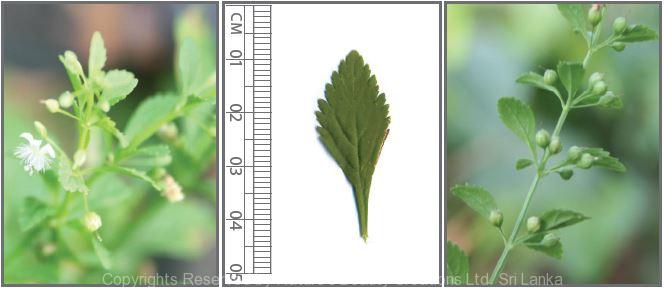

Traditional Knowledge
Useful plant parts :
Young leaf and whole plant
Uses in traditional medicine :
- Porridge made of young leaves is taken by diabetic patients to reduce blood glucose level
- Whole plant possesses anti-inflammatory, antifebrile and diuretic properties and is used in coryza, hyperthemlia, sore throat, cough, erythema, measles, boils, impetigo and menorrhagia
Scientific Research
Chemical constituents:
Terpenes: scoparic acids A–D, scopadulcic acids A and B, scoparinol, dulcinol, scopadulciol, glutinol, flavonoid: acacetin and benzoxazinoids from plant
Bioactivity :
Aqueous extract of leaves and scoparic acid D: hypoglycaemic; scoparinol: anti-inflammatory, analgaesic; ethanol extract of roots: antibacterial; scopadulciol: inhibit gastric H+ and K+-ATPhase; scopadulcic acid B: inhibits HSV-1, antitumour; aqueous ethanol extract of whole plant: antioxidative, attenuate hyperglycaemia, hepatoprotective, antiulcer; benzoxazinoids: anticancer
Clinical:
References : Ahmed, M. et al., (2001), Analgesic, diuretic, and anti-inflammatory principle from Scoparia dulcis, Pharmazi, 56(8), 657-60. Ahmed, M. and Jakupovic, J., (1990), Diterpenoids from scoparia dulcis, Phytochemistry, 29(9), 3035-3037. Babincová, M. et al., (2008), Antiulcer activity of water extract of Scoparia dulcis, Fitoterapia, 79(7-8), 587-8. Hayashi, K. et al., (1988), In vitro and in vivo antiviral activity of scopadulcic acid B from Scopariadulcis, Scrophulariaceae, against herpes simplex virus type 1, Antiviral Research, 9(6), 345–354. Hayashi, T. et al., (1991), Scopadulciol, an Inhibitor of Gastric H+,K+ATPhase from Scoparia dulcis, and Its Structure-Activity Relation- ships, Journal of Natural Products, 54(3), 802–809. Latha, M. and Pari, L., (2004), Effect of an aqueous extract of Scoparia dulcis on blood glucose, plasma insulin and some polyol pathway enzymes in experimental rat diabetes, Brazilian Journal of Medical and Biological Research, 37(4), 577-586. Latha, M. et al., (2009), Antidiabetic effects of scoparic acid D isolated from Scoparia dulcis in rats with streptozotocin-induced diabetes, Nat Prod Res, 23(16), 1528-40. Nishino, H. N. T. et al., (1993), Antitumor-Promoting Activity of Scopadulcic Acid B, Isolated from the Medicinal Plant Scoparia dulcis L., Oncology, 50(2),100–103. Pari, L. and Venkateswaran, S., (2002), Hypoglycaemic Activity of Scoparia dulcis L. Extract in Alloxan Induced Hyperglycaemic Rats, Phytotherapy Research, 16, 662–664. Ratnasooriya, W. D. et al., (2005), Antioxidant activity of water extract of Scoparia dulcis, Fitoterapia, 76(2), 220–222. Tsai, J. C. et al., (2010), Hepatoprotective effect of Scoparia dulcis on carbon tetrachloride induced acute liver injury in mice, Am J Chin Med, 38(4), 761-75. Wu, W. H. et al., (2012), Benzoxazinoids from Scoparia dulcis (sweet broomweed) with antiproliferative activity against the DU-145 human prostate cancer cell line, Phytochemistry, 83, 110-5. Yisa, J. et al., (2009), Phytochemical analysis and antimicrobial activity of Scoparia dulcis and Nymphaea lotus, Australian Journal of Basic and Applied Sciences, 3(4), 3975-3979.
Copyrights Reserved By
Natures Beauty Creations



